This article was medically reviewed by Luba Lee, FNP-BC, MS. Luba Lee, FNP-BC is a Board-Certified Family Nurse Practitioner (FNP) and educator in Tennessee with over a decade of clinical experience. Luba has certifications in Pediatric Advanced Life Support (PALS), Emergency Medicine, Advanced Cardiac Life Support (ACLS), Team Building, and Critical Care Nursing. She received her Master of Science in Nursing (MSN) from the University of Tennessee in 2006.
There are 14 references cited in this article, which can be found at the bottom of the page.
wikiHow marks an article as reader-approved once it receives enough positive feedback. In this case, 87% of readers who voted found the article helpful, earning it our reader-approved status.
This article has been viewed 117,758 times.
A scrape is a wound that generally does not go all the way through your skin, unlike a cut, which generally goes through your skin to the muscle below. Regardless, deep scrapes can be painful and bloody. If you have sustained a deep scrape, you can try treating your injury at home, or you can head to the doctor’s office. Deep scrapes that are not quite that deep can generally be compressed, washed, and bandaged at home.
Things You Should Know
- Wash your hands with soap and water before you rinse the wound with warm water to clean it out.
- Apply pressure with a clean cloth to stop any bleeding and apply an antibiotic cream before dressing the wound.
- Bandage the wound with gauze and medical tape; change your dressing at least once every day until the wound heals.
- If the scrape is more than 1⁄4 inch (0.64 cm) deep, it won’t stop bleeding, or you see signs of an infection, do not hesitate to go to an emergency room.
Steps
First Aid
-
1Examine the wound to determine how deep it is. Sometimes, a scrape and a laceration can appear similar. Before you treat a scrape, you need to make sure you have one. This is important because lacerations, or cuts, may require sutures (stitches) or glue for treatment if they are long or gaping open. A scrape is a shallow skin abrasion that is over a portion of the skin.[1]
- If you have a wound that is over .25 inches (0.64 cm) deep, seek medical help to treat the wound and stitch it up.[2]
-
2Wash your hands with soap and water. Before you take care of your wound, make sure you have clean hands. As long as your wound is not bleeding excessively, take the time to wash your hands with antibacterial soap. If the deep scrape is on your hands, try not to get the soap on the wound because it will hurt.[3]
- If you don’t have access to soap and water, wipe any obvious dirt off your hands and then rub them with hand sanitizer until they feel dry (usually 20-30 seconds).
Advertisement -
3Rinse the scrape with warm water. After you determine that the wound is a scrape, rinse it with water. Run water over the wound to remove any debris that may have gotten into it when you were injured. The water should be lukewarm. Continuously run or pour water over the scrape for a few minutes at a time. In between, check to make sure there is not more debris in the wound.[4]
- If you are not in a place where there is a clean and available water source, remove the obvious debris by brushing it away with a clean cloth.
- If you notice excessive bleeding, rinse for as little time as possible to remove the debris. Then, move on to the next step.
- Most healthcare professionals no longer recommend pouring antiseptics, such as alcohol, hydrogen peroxide, or iodine over a wound. These chemicals may irritate the damaged tissue and slow down healing.[5]
-
4Apply pressure to stop any bleeding. Once any large debris or matter is removed, you need to stop the bleeding. To do this, take a clean cloth, towel, or gauze and cover the wound. Apply firm pressure to the wound. If you only have a used shirt or dirty cloth, don't worry too much. Your wound is already dirty because it hasn't been disinfected. Just focus on stopping the bleeding.[6]
- Once you begin applying pressure, refrain from checking on the wound for at least 15 minutes. If you stop applying pressure too soon, the blood clot will not form and bleeding will begin again.[7]
-
5Seek medical attention if the wound is severe. If your compression cloth becomes soaked with blood or if you notice squirting blood flow, seek medical attention immediately. This means that your wound is severe and needs more advanced help from a doctor. This may happen with large scrapes, such as road rashes or scrapes of an excessive length.[8]
- Some medical conditions, such as bleeding or clotting disorders, diabetes, kidney disease, or circulation problems, can put you at greater risk of complications from cuts or scrapes.[9] If you have one of these health concerns, call your doctor or visit an urgent care clinic if you get a deep scrape or a more serious cut.
Hygiene and Dressing
-
1Remove any stuck in debris. Sometimes, pieces of debris may be lodged in the skin that did not come out with rinsing, especially with scrapes. Once the bleeding has stopped, look at the wound for extra debris in the skin. If you see any debris, use tweezers to gently remove it. If the debris will not come out, see your doctor to have it removed.[10]
- Do not dig the tweezers into the wound. You don't want to injure yourself further.
- If you don’t find any debris, you can move on to the next step.
-
2Apply antibiotic cream to the scrape. Even if you think you have removed all of the dirt and debris, there is still a chance that your wound could become infected. Because of this, applying some antibiotic cream to the wound is always a good idea. This ointment will also keep your scrape moist so it won’t crack and get worse when you move around. A thin layer of antibiotic ointment or petroleum jelly covering the area of the wound should be enough.[11]
- Neosporin, Polysporin and Bacitracin are 3 of the most common products used.
- Look for a multi-action antibacterial ointment, such as Neosporin Pain/Itch/Scar ointment, that can reduce pain and itching as well as preventing infection and promoting faster healing. You can purchase these kinds of ointments over-the-counter.
-
3Bandage the wound. Take gauze or large bandage and cover your wound. Take medical tape and cover each of the edges. This will help keep out debris, germs, and other particulates. If your scrape isn't too large, you may be able to use a large band-aid instead of gauze.[12]
- These supplies can be found in most drug stores and pharmacies.
- If the wound is over a flexible joint, rolled gauze may be more easily managed. You can secure a dressing with this kind of gauze more easily and it will be less likely to fall off.
-
4Change the dressing at least once a day. Take the bandage off so you can clean the wound and apply fresh dressings. This is also a good opportunity to look at the wound and check to see if any infection is occurring. Do not leave a dressing on for more than 24 hours.[13]
- Change the bandages any time they get wet or dirty, as dirty bandages can lead to your scrape becoming infected.
-
5Watch for signs of infection, such as redness or pus. Despite your efforts to keep the scrape clean, you may still get an infection. This will depend on the size of the scrape as well as other factors, such as your age, overall health, and any conditions such as diabetes and obesity. These can affect your healing time as well. Look out for redness around the wound or on the edges, especially if expands from one day to the next. The wound may also start draining or oozing pus.[14]
- Other signs of an infection include increasing pain, swelling, or warmth around the wound. You may also develop a fever or feel generally unwell.[15]
Infections
-
1Go to a doctor if you suspect an infection. If you think your wound might be infected or if the bleeding will not stop after applying pressure, seek medical attention. If you have had the wound for a while and have noticed that it has gotten infected, you should also go see a doctor. Letting an infection linger can lead to blood poisoning and other life-threatening situations.[16]
- Call your doctor immediately or go to urgent care if your skin is warm around the wound or the scrape is leaking yellow or greenish discharge.
- If you notice bright yellow or black discoloration around your wound, go to the hospital immediately.
-
2Get a tetanus shot if you haven’t had one in the past 5 years. If you have a wound that’s especially deep or dirty, your doctor might recommend a tetanus shot.[17] This is especially important if you haven’t had a tetanus shot recently (within the past 5-10 years).
- You should get the shot as soon as possible after the injury to ensure that you do not develop tetanus. Tetanus is a dangerous, potentially deadly bacterial infection that causes severe, painful muscle spasms.[18]
-
3Take antibiotics if your doctor prescribes them. If your scrape is deep or badly infected, your doctor may prescribe antibiotics to take to combat or prevent further infection. The type of antibiotic they prescribe may depend on how serious your infection is or what kind of bacteria are causing the infection. Follow your doctor’s instructions when it comes to taking the medication.[19]
- You may also be prescribed painkillers depending on how painful your wound is.
- Tell your doctor about any other medications or supplements you may be taking, since this could affect which antibiotics you can use safely.
- Let your doctor know if you have any medication allergies or health conditions that could affect which antibiotics you can take.
Expert Q&A
-
QuestionIf an elderly person with thin skin has a large abrasion that pools blood when the bandage is changed, what should they do?
 Luba Lee, FNP-BC, MSLuba Lee, FNP-BC is a Board-Certified Family Nurse Practitioner (FNP) and educator in Tennessee with over a decade of clinical experience. Luba has certifications in Pediatric Advanced Life Support (PALS), Emergency Medicine, Advanced Cardiac Life Support (ACLS), Team Building, and Critical Care Nursing. She received her Master of Science in Nursing (MSN) from the University of Tennessee in 2006.
Luba Lee, FNP-BC, MSLuba Lee, FNP-BC is a Board-Certified Family Nurse Practitioner (FNP) and educator in Tennessee with over a decade of clinical experience. Luba has certifications in Pediatric Advanced Life Support (PALS), Emergency Medicine, Advanced Cardiac Life Support (ACLS), Team Building, and Critical Care Nursing. She received her Master of Science in Nursing (MSN) from the University of Tennessee in 2006.
Board-Certified Family Nurse Practitioner When you change the bandage, rinse the abrasion with sterile saline, pat it dry, and apply pressure over the abrasion to make the blood clot before applying ointments, silicone sheets, or a bandage over the abrasion. Increased bleeding in the elderly can be due to the medications that they are taking (aspirin or blood thinners) and if you see increased bruising in other places and easy or excessive bleeding from the abrasion, please contact and discuss these findings with a health-care provider.
When you change the bandage, rinse the abrasion with sterile saline, pat it dry, and apply pressure over the abrasion to make the blood clot before applying ointments, silicone sheets, or a bandage over the abrasion. Increased bleeding in the elderly can be due to the medications that they are taking (aspirin or blood thinners) and if you see increased bruising in other places and easy or excessive bleeding from the abrasion, please contact and discuss these findings with a health-care provider. -
QuestionHow do I treat the pain of a deep scrape?
 Luba Lee, FNP-BC, MSLuba Lee, FNP-BC is a Board-Certified Family Nurse Practitioner (FNP) and educator in Tennessee with over a decade of clinical experience. Luba has certifications in Pediatric Advanced Life Support (PALS), Emergency Medicine, Advanced Cardiac Life Support (ACLS), Team Building, and Critical Care Nursing. She received her Master of Science in Nursing (MSN) from the University of Tennessee in 2006.
Luba Lee, FNP-BC, MSLuba Lee, FNP-BC is a Board-Certified Family Nurse Practitioner (FNP) and educator in Tennessee with over a decade of clinical experience. Luba has certifications in Pediatric Advanced Life Support (PALS), Emergency Medicine, Advanced Cardiac Life Support (ACLS), Team Building, and Critical Care Nursing. She received her Master of Science in Nursing (MSN) from the University of Tennessee in 2006.
Board-Certified Family Nurse Practitioner Rinse your deep scrape with warm water, pat it dry with clean towel or paper towel and apply a thin layer of multi-action ointment such as Neosporin+Pain Relief.
Rinse your deep scrape with warm water, pat it dry with clean towel or paper towel and apply a thin layer of multi-action ointment such as Neosporin+Pain Relief.
References
- ↑ https://www.seattlechildrens.org/conditions/a-z/cut-scrape-or-bruise/
- ↑ https://medlineplus.gov/ency/article/000043.htm
- ↑ https://www.cdc.gov/healthywater/hygiene/hand/handwashing.html
- ↑ https://www.mayoclinic.org/first-aid/first-aid-cuts/basics/art-20056711
- ↑ https://www.aafp.org/afp/2002/0715/p315.html
- ↑ https://myhealth.alberta.ca/Health/pages/conditions.aspx?hwid=zm6160
- ↑ https://myhealth.alberta.ca/HEALTH/Pages/conditions.aspx?hwid=zm6160
- ↑ https://kidshealth.org/en/teens/cuts.html
- ↑ https://www.medstargoodsam.org/our-services/wound-care/wound-prevention/
- ↑ https://www.mayoclinic.org/first-aid/first-aid-cuts/basics/art-20056711
- ↑ https://www.aad.org/public/everyday-care/injured-skin/burns/wound-care-minimize-scars
- ↑ https://www.mayoclinic.org/first-aid/first-aid-cuts/basics/art-20056711
- ↑ https://www.aad.org/public/everyday-care/injured-skin/burns/wound-care-minimize-scars
- ↑ https://www.mayoclinic.org/first-aid/first-aid-cuts/basics/art-20056711
- ↑ https://kidshealth.org/en/teens/cuts.html
- ↑ https://medlineplus.gov/ency/article/007645.htm
- ↑ https://www.nhs.uk/common-health-questions/accidents-first-aid-and-treatments/do-i-need-a-tetanus-jab-vaccine-after-an-accident-or-injury/
- ↑ https://medlineplus.gov/tetanus.html
- ↑ https://www.fairview.org/patient-education/85329
About This Article
To treat a deep scrape, rinse the wound with clean, lukewarm water so you can remove any debris that may have gotten inside of it. When all the debris is gone, apply solid pressure to the wound with a clean cloth to stop the bleeding. Once your scrape has stopped bleeding, rinse the wound again and then clean it with an antiseptic like hydrogen peroxide. Next, put a thin layer of antibiotic cream like Neosporin on the scrape and apply a bandage or gauze to prevent infection. If your scrape won’t stop bleeding, seek medical attention as soon as possible. For more help from our Medical co-author, including what to do if your scrape gets infected, read on!
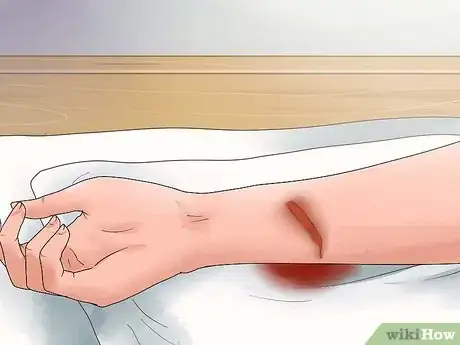
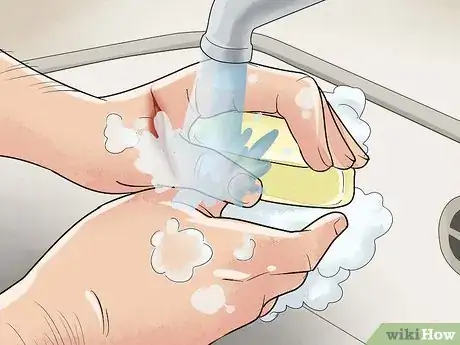
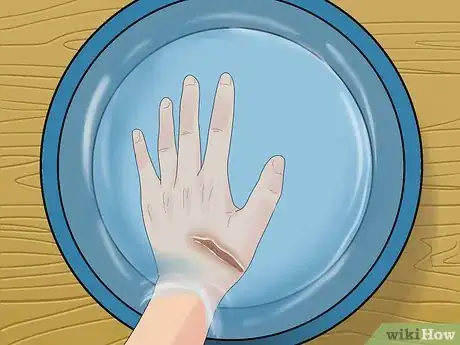
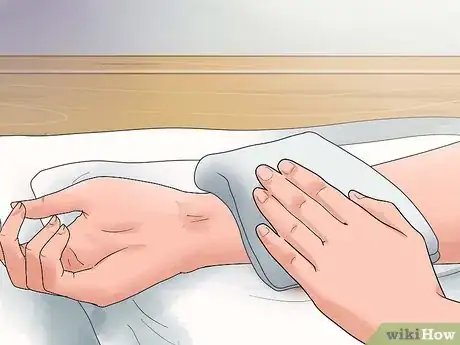
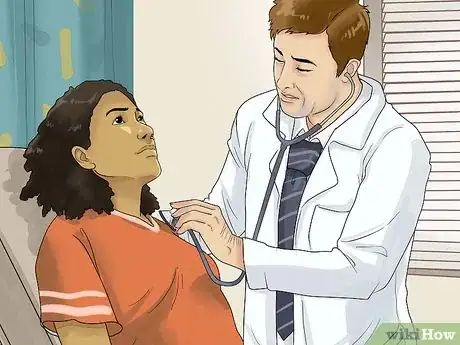
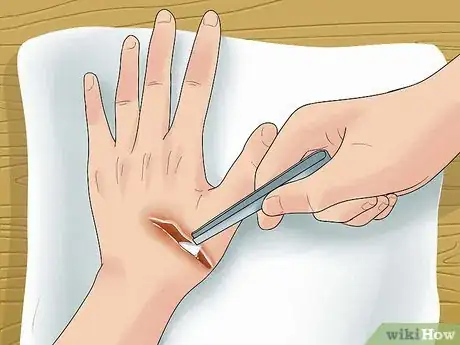
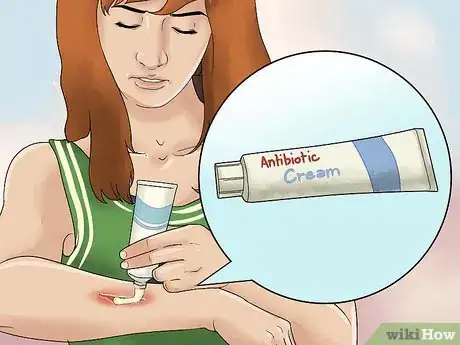
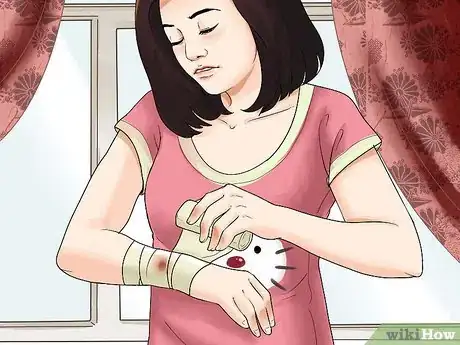
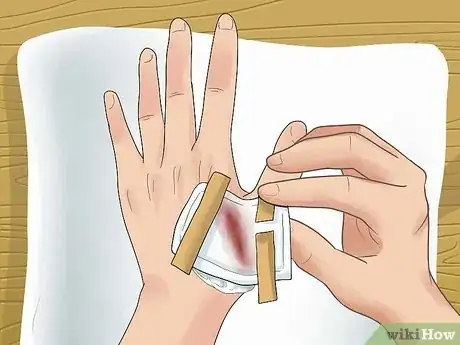
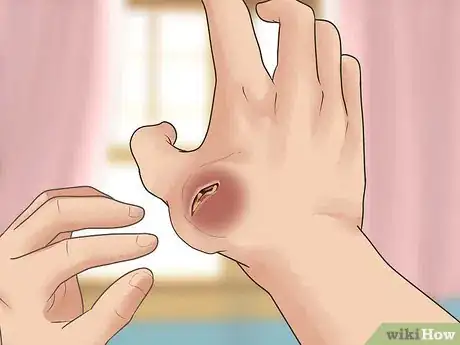

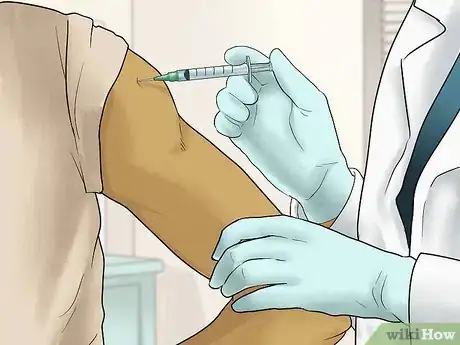
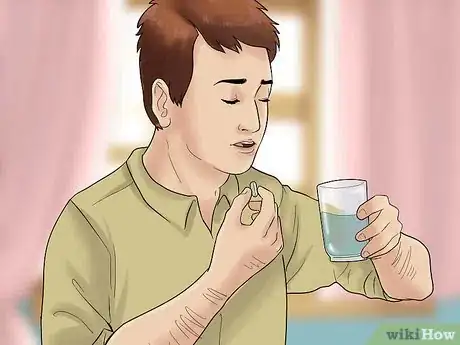
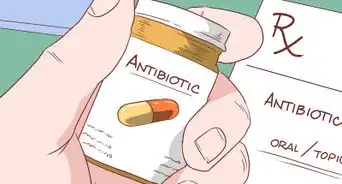

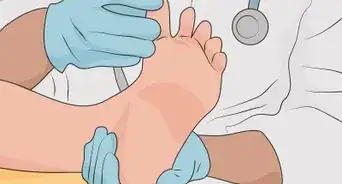
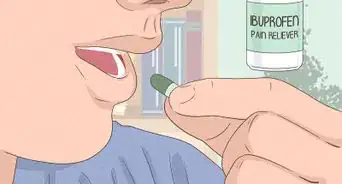
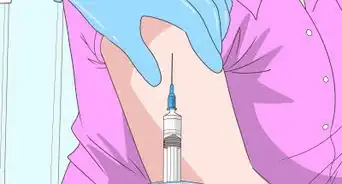

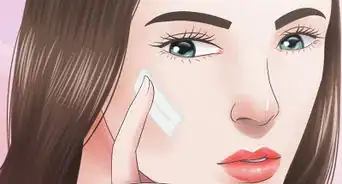
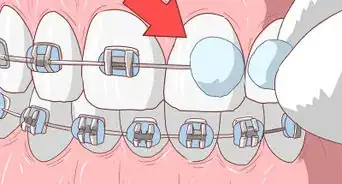

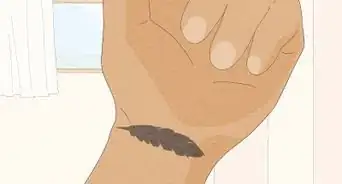

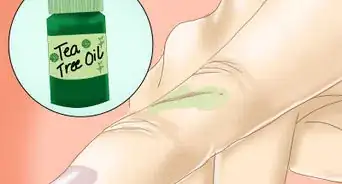









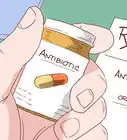
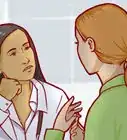
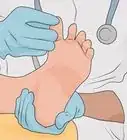
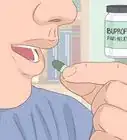



































Medical Disclaimer
The content of this article is not intended to be a substitute for professional medical advice, examination, diagnosis, or treatment. You should always contact your doctor or other qualified healthcare professional before starting, changing, or stopping any kind of health treatment.
Read More...